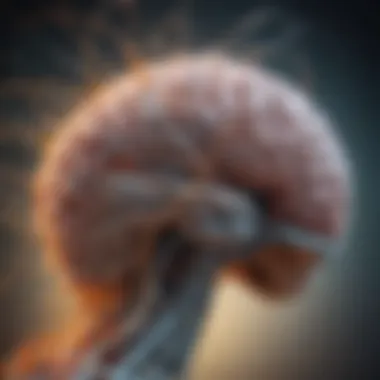Neuromodulation: A Novel Approach to Tinnitus Treatment


Overview of Research Topic
Tinnitus, often described as a relentless ringing or buzzing in the ears, can truly distort one’s perception of silence. It’s a condition affecting millions, yet research into effective treatments has often lagged behind. Enter neuromodulation, a method that’s gaining traction in treating this perplexing ailment. It encompasses various techniques that influence nerve activity, offering a novel approach to alleviating symptoms of tinnitus.
Brief Background and Context
The complexity of tinnitus presents a daunting challenge for researchers and clinicians alike. This condition can stem from a host of causes—exposure to loud noise, age-related hearing loss, or even underlying health conditions such as ear infections or jaw disorders. Most treatments have focused on counseling, sound therapy, or medications, but these approaches often yield only partial relief.
In contrast, neuromodulation aims at modifying the neural circuits involved in sound perception and auditory processing. This technique has gained attention recently, as it is thought to target the root causes of tinnitus rather than just masking the symptoms. By understanding these neural pathways more thoroughly, we inch closer to developing more effective treatments.
Importance in Current Scientific Landscape
Neuromodulation is reshaping our understanding of tinnitus management. In a scientific terrain that often feels like a maze of trial and error, neuromodulation stands out as an emerging beacon of hope.
Recent clinical trials suggest that it may have the potential to change the conversation about tinnitus treatment significantly. The evolution of this treatment modality invites not just researchers but also patients and practitioners to reconsider existing paradigms. As we delve deeper into this field, the need for robust clinical data and continued research remains paramount.
"Understanding the dynamics of neuromodulation can potentially provide tinnitus sufferers with tools that offer genuine improvements in their quality of life."
Methodology
While delving into the field of neuromodulation for tinnitus, researchers have adopted diverse methodologies to explore its efficacy. This section outlines how studies are largely framed and the techniques employed for data collection.
Research Design and Approach
The research landscape in this domain often includes both longitudinal and cross-sectional studies. Many approaches focus on:
- Randomized Controlled Trials (RCTs): These are pivotal in establishing efficacy and safety. In RCTs, participants are randomly assigned to treatment or control groups, which helps in drawing more reliable conclusions.
- Pilot Studies: Preliminary investigations that explore the feasibility of neuromodulation techniques on a small scale, these studies are essential for identifying effective protocols before larger trials commence.
Data Collection Techniques
Effective data collection is crucial, and the following methods are commonly implemented:
- Questionnaires and Surveys: Participants may fill in structured questionnaires that assess their perception of tinnitus severity before and after treatment.
- Neuroimaging Techniques: Advanced imaging techniques like fMRI or PET scans play a role in visualizing brain activity and understanding how neuromodulation influences the auditory cortex.
- Auditory Assessments: These tests evaluate changes in hearing ability or response to sound stimuli over the treatment period.
By employing such varied and rigorous research methodologies, the field aims to uncover the roles that neuromodulation can play in effectively managing and potentially alleviating tinnitus symptoms.
Intro to Tinnitus
Tinnitus, although experienced by many, is often shrouded in misunderstanding. It’s not just ringing in the ears; it can manifest as buzzing, hissing, or even clicking sounds. The subjective nature of tinnitus makes it an elusive condition to define, and its impacts are manifold. Understanding tinnitus is essential because it lays the groundwork for exploring innovative treatments such as neuromodulation. As our society becomes more aware of mental health and wellness, suitable treatments for conditions like tinnitus don’t just benefit those affected but also contribute significantly to overall quality of life.
Defining Tinnitus and Its Classification
Tinnitus is commonly defined as the perception of sound when no external sound is present. It's a symptom rather than a disease itself, and its classification can be broadly divided into two main categories: subjective and objective tinnitus. Subjective tinnitus is the most prevalent type, where only the individual with the condition can hear the sound. On the other hand, objective tinnitus can be heard by an examiner through the use of specialized instruments; this form is often linked to underlying physiological issues.
The classification can also reflect the sound’s characteristics, such as pulsing, constant, or intermittent sounds. In terms of duration, tinnitus may be classified as temporary or chronic. Chronic tinnitus lasts longer than six months, which can severely affect daily living. Understanding these classifications not only allows for better diagnosis but also opens the door to targeted therapies that address specific types of tinnitus.
Prevalence and Impact on Daily Life


Tinnitus is surprisingly common, affecting an estimated 15 to 20% of the adult population in the U.S. alone. The numbers can climb higher in specific demographics, particularly among older adults and those with hearing loss. It’s noteworthy that the subjective experience of tinnitus varies widely among individuals.
The impact of tinnitus on daily life cannot be overstated. Many individuals report challenges like difficulty concentrating, sleep disturbances, and significant emotional distress. This ongoing struggle can lead to higher rates of anxiety and depression, affecting mental health and overall well-being.
An article in Wikipedia mentions that tinnitus is linked to various health issues, including hypertension and earwax blockage, which can further complicate someone’s situation. For those who suffer from it long-term, it is not just a sound; it’s a constant reminder of discomfort that reverberates through their existence.
Embracing a better understanding of tinnitus is crucial not only for those directly affected but also for healthcare professionals and researchers focused on developing effective treatments. Through comprehensive discussions of such topics, this article sheds light on the significance of exploring newer avenues such as neuromodulation as potential therapies for managing tinnitus.
Understanding Neuromodulation
Understanding neuromodulation is essential in the context of tinnitus treatment because it explores how certain brain pathways can be altered to relieve symptoms like persistent ringing in the ears. This section uncovers the reasons behind the growing interest in neuromodulatory techniques and their potential benefits over conventional therapies. The intricacies of brain functioning play a pivotal role in tinnitus, and neuromodulation seeks to address these by providing targeted interventions that can adjust abnormal neural activities.
Neuromodulation may offer a fresh approach where traditional methods fall short. It introduces non-invasive and minimally invasive technology that can provide relief without the need for medication or invasive procedures. With the prevalence of tinnitus on the rise, especially among older adults, this area of study deserves attention as a possible means for improving quality of life.
Concept and Mechanism of Neuromodulation
Neuromodulation involves the modulation of nerve activity through targeted delivery of electrical signals or chemical substances. In simpler terms, it's like signalling to the brain to adjust the volume on certain pathways. This mechanism hinges on neurotransmitters—chemical messengers that transfer signals across synapses in the brain. By modulating these signals, it is possible to influence how tinnitus is perceived.
Neuromodulation approaches aim to recalibrate brain networks involved in auditory perception. For instance, abnormal neural firing associated with tinnitus can be suppressed. When these signals are adjusted effectively, the perception of sound can become less intrusive, leading individuals to experience a lower intensity of tinnitus sensations.
Different Neuromodulation Techniques
Neuromodulation isn’t one-size-fits-all; it comes in various forms. These techniques vary not only in their approaches but also in their mechanisms of action. Let’s look closer at these methods:
Transcranial Magnetic Stimulation
Transcranial Magnetic Stimulation (TMS) is one of the frontrunners in this field, tapping into magnetic fields to stimulate nerve cells in the brain. A compelling characteristic that sets TMS apart is its non-invasive nature, as it provides a way to influence brain function without any surgical procedures. This makes it an attractive choice for patients wary of invasive treatments.
The unique feature of TMS lies in its ability to target specific regions of the brain that are linked with auditory processing, like the temporal lobe. By delivering precisely timed magnetic pulses, it can decrease the hyperactivity of neurons associated with the perception of ringing. However, challenges exist, such as variations in patient responses and some reports of discomfort during treatments.
Transcranial Direct Current Stimulation
Transcranial Direct Current Stimulation (tDCS) uses a low electrical current applied to the scalp to modulate neuronal activity. Its simplicity stands out—it’s portable and can even be administered at home under proper guidance. This has made it an increasingly popular technique among researchers and clinicians.
The core feature of tDCS is its capability to either enhance or inhibit the excitability of neural circuits, depending on the polarity of the electrodes used. It offers an advantage in its accessibility and cost-effectiveness compared to other neuromodulation techniques. Still, some studies highlight the variability in efficacy and the temporary nature of its effects.
Vagus Nerve Stimulation
Vagus Nerve Stimulation (VNS) extends beyond just auditory symptoms, as it influences various physiological processes. By stimulating the vagus nerve, this method aims to impact brain areas associated with emotional regulation and auditory processing, potentially leading to improved tinnitus outcomes.
The notable aspect of VNS is its approval for treating other conditions, such as epilepsy and depression, which broadens its applicability in clinical settings. However, this technique is invasive and may carry risks associated with surgery, including the possibility of infection or discomfort at the implant site.
In summarizing the neuromodulation techniques discussed, it is clear that each possesses unique strengths and caveats. This variety opens pathways for personalized tinnitus treatments, making the understanding of these methods even more crucial as we seek viable alternatives for managing this challenging condition.
Neuromodulation and Tinnitus Treatment
Tinnitus, often described as a persistent ringing or buzzing in the ears, can be a frustrating condition for those who suffer from it. As traditional therapies can sometimes feel like a drop in the ocean, emerging treatments like neuromodulation are becoming increasingly relevant. Neuromodulation offers a fresh perspective and a glimmer of hope for relief. This section will explore the importance of neuromodulation in treating tinnitus, including its specific elements, benefits, and the considerations practitioners and patients may need to keep in mind.
Mechanisms of Action in Tinnitus Management


Understanding how neuromodulation works is crucial for grasping its potential in tinnitus management. At its core, neuromodulation involves modifying nerve activity by delivering electrical or chemical stimuli to specific brain regions or pathways. In the context of tinnitus, this can involve approaches that change how the auditory system processes sound. When the brain's pathways become entangled due to hearing loss or auditory nerve damage, neuromodulation can help untangle these pathways.
Key mechanisms that contribute to its action include:
- Balancing Neurotransmitter Levels: Neuromodulation can adjust the levels of neurotransmitters like dopamine or serotonin, promoting a healthier auditory environment that may alleviate tinnitus perception.
- Rewiring Neural Circuits: Neuromodulatory techniques have the potential to rewire neural connections, helping the brain learn to ignore the phantom sounds associated with tinnitus.
- Enhancing Auditory Processing: By stimulating certain regions of the brain associated with sound processing, neuromodulation may enhance how auditory information is interpreted, reducing the subjective perception of tinnitus.
The interplay of these mechanisms underscores neuromodulation's promise in managing tinnitus, and patient outcomes have the potential to improve through its application.
Current Research Findings
Current research into neuromodulation methods for tinnitus treatment is gaining traction, showcasing various results that highlight the effectiveness and viability of these techniques. Findings so far suggest that neuromodulation may equip clinicians and patients with practical alternatives to traditional forms of therapy. Some prominent insights from ongoing studies include:
- Transcranial Magnetic Stimulation: Research demonstrates that this technique can lead to significant reduction in tinnitus symptoms in certain individuals, showing promise as a non-invasive treatment.
- Transcranial Direct Current Stimulation: Trials indicate that applying low electrical currents to the scalp can modulate brain activity, resulting in decreased tinnitus severity.
- Vagus Nerve Stimulation: Ongoing studies are revealing how this technique, when coupled with auditory stimuli, may effectively target the neural correlates of tinnitus.
"Recent studies point to a growing body of evidence supporting neuromodulation techniques as valid alternatives in tinnitus treatment, offering new hope to patients who have exhausted traditional methods."
These advancements underline the potential significance of neuromodulation in clinical settings while paving the way for more extensive trials. As research continues to evolve, more targeted approaches may emerge, solidifying neuromodulation's place in tinnitus management.
Comparative Effectiveness of Neuromodulation
Understanding the comparative effectiveness of neuromodulation as a treatment for tinnitus is crucial for both clinicians and patients. Given the persistent and often debilitating nature of tinnitus, determining which treatment approach yields the best outcomes can inform better clinical practices and patient choices. As the medical community looks for innovative solutions to manage tinnitus, understanding how neuromodulation stacks up against traditional therapies will bear significant weight in informed decision-making.
The advent of neuromodulation techniques such as Transcranial Magnetic Stimulation, Transcranial Direct Current Stimulation, and Vagus Nerve Stimulation is changing the landscape of tinnitus treatment. Each method comes with unique protocols and modes of action that could potentially redefine effectiveness. This section will evaluate differences in effectiveness, side effects, and overall patient satisfaction in comparison to conventional tinnitus therapies.
Neuromodulation vs. Traditional Tinnitus Therapies
Traditional tinnitus treatments often include sound therapy, cognitive-behavioral therapy, and various medications. Each of these approaches seeks to alleviate the condition by targeting auditory pathways, emotional responses, or altering perceptions of sound. However, while many patients may find temporary relief through these methods, they frequently manage symptoms rather than addressing the underlying mechanisms of tinnitus.
On the other hand, neuromodulation techniques delve deeper into the neurological pathways associated with tinnitus. Research indicates that neuromodulation can lead to long-lasting adjustments in how the brain processes sound, thereby potentially offering more sustainable relief. For instance, Transcranial Magnetic Stimulation offers a non-invasive way to stimulate areas of the brain linked to auditory processing. Studies suggest that it can result in significant reductions in tinnitus loudness and distress levels.
"Research demonstrates that neuromodulation techniques, due to their direct influence on neural circuitry, might offer more than just symptomatic relief; they hold the promise of long-term brain alterations that can change the perception of tinnitus."
Moreover, neuromodulation has the advantage of being tailored to individual patient needs, enhancing its effectiveness. For patients who have not responded well to traditional treatments, neuromodulation presents a promising alternative that offers hope where other methods have faltered.
Patient-Centered Outcomes
Evaluating patient-centered outcomes is vital when considering the effectiveness of any treatment modality. Neuromodulation stands out in prioritizing the holistic experience of the patient, not just clinical metrics. Research often examines quality of life, emotional well-being, and subjective perceptions of tinnitus post-therapy. These outcomes provide a fuller picture of the impact of treatment.
Unlike traditional therapies, which can leave patients feeling helpless or pessimistic about their condition, neuromodulation appears to empower individuals. Patients frequently report a greater sense of agency in managing their tinnitus after undergoing neuromodulation treatments. This shift may stem from enhanced coping strategies and a more proactive approach to managing their auditory symptoms.
To summarize the patient-centered outcomes:
- Improved Quality of Life: Many patients report a notable improvement in their daily lives following neuromodulation treatment.
- Emotional Resilience: There's evidence that such treatments can help reduce anxiety and depression related to tinnitus.
- Long-Term Satisfaction: Patients often express greater overall satisfaction with neuromodulation approaches as opposed to traditional methods.
In summary, the comparative effectiveness of neuromodulation against traditional tinnitus therapies reveals a promising avenue for future research and treatment. As more patients seek effective solutions to their tinnitus challenges, understanding these different approaches will become increasingly important in achieving better outcomes.
Benefits and Limitations of Neuromodulation
The conversation surrounding tinnitus treatment is shifting, as many look toward innovative solutions. Neuromodulation stands at the forefront of this discussion, showcasing both promise and areas that require careful consideration. The significance of understanding these benefits and limitations lies in informing patients, researchers, and healthcare professionals. By recognizing what neuromodulation has to offer, alongside its potential drawbacks, stakeholders can make well-rounded decisions regarding management strategies for tinnitus.


Advantages of Neuromodulation Techniques
Neuromodulation’s various techniques offer a fresh perspective in treating tinnitus. Here are a few advantages that stand out:
- Non-invasive Approaches: Many neuromodulation techniques, like Transcranial Magnetic Stimulation (TMS), are designed to be non-invasive. This is crucial since patients often look for safer alternatives to traditional invasive surgeries or pharmaceuticals.
- Personalized Treatment: Due to the diverse nature of tinnitus, neuromodulation allows for tailored treatments. Clinicians can adjust protocols based on individual responses, making this approach more adaptable than one-size-fits-all therapies.
- Potential for Long-lasting Relief: Some studies suggest that the effects of neuromodulation may persist beyond treatment sessions. This means patients might enjoy longer periods of relief from their symptoms, which is a significant improvement for many.
- Neuroplasticity Promotion: Neuromodulation can potentially encourage the brain to reorganize itself, allowing for better management of auditory experiences. This rearrangement may help patients develop a new relationship with their tinnitus.
- Minimal Side Effects: Compared to pharmaceutical options, which can lead to a range of side effects, neuromodulation techniques typically present with fewer adverse reactions. This makes them appealing for concerned patients.
Potential Risks and Considerations
However, alongside these advantages, there are notable risks and considerations that require examination:
- Variability in Responses: Just as effective as treatments can be, responses are uneven among individuals. What may help one patient significantly might hold little value for another.
- Limited Understanding of Mechanisms: The intricacies of how neuromodulation alters tinnitus perception remain largely elusive. This gap in knowledge can lead to hesitancy among clinicians and patients alike.
- Cost and Accessibility: Advanced neuromodulation equipment and training can be financially burdensome, potentially limiting access for some patients. This raises questions about equality in care.
- Need for Further Research: While promising, many neuromodulation techniques are still in developmental stages, and long-term efficacy and safety need further exploration. Ongoing studies will clarify these unknowns to support clinical decisions.
- Lifestyle Compatibility: Some neuromodulation techniques require frequent sessions, which may not fit into every patient's lifestyle. This commitment can deter individuals from fully engaging in treatment.
"As the field of neuromodulation evolves, understanding both the bright and shadowy sides becomes imperative for those navigating tinnitus treatment pathways."
These advantages and potential pitfalls define the essence of neuromodulation strategies. Evaluation of these factors can guide patients through a landscape filled with choices, ultimately enhancing the management of tinnitus.
Future Directions in Tinnitus Treatment
As the scientific community continues to dissect the intricate web of tinnitus and its impacts, the pursuit of effective treatments grows ever more important. This section delves into the future directions in tinnitus management, particularly focusing on neuromodulation. By placing a spotlight on this frontier, we aim to unveil the potential for transformative therapies that can significantly enhance the quality of life for those affected.
Innovative Research and Development
Innovative research acts as the bedrock of future tinnitus treatments. Presently, a number of studies are underway that aim to deepen our understanding of how neuromodulation can be further optimized for tinnitus management.
- Targeted Neural Pathways: Researchers are exploring how to specifically target neural circuits involved in auditory processing. Identifying these pathways allows for tailored interventions, potentially maximizing effectiveness while minimizing side effects.
- Neuroplasticity: The concept of neuroplasticity—a brain's ability to reorganize itself by forming new neural connections—plays a pivotal role. Ongoing studies investigate whether neuromodulation can harness this adaptability, helping to rewire the brain's response to tinnitus.
- Personalized Therapy Approaches: Another hot topic in research is the development of personalized therapy. Using biomarkers and genetic profiling, future treatments might be able to cater uniquely to each patient's tinnitus profile, leading to better treatment outcomes.
"As research continues to evolve, it is crucial that we stay abreast of the findings that could reshape tinnitus management practices."
Emerging Technologies in Neuromodulation
Advancements in technology consistently push the boundaries of what we know about tinnitus treatment. Emerging technologies in neuromodulation hold promise, bringing new avenues for exploration and implementation in clinical settings.
- Wearable Devices: The introduction of wearable technologies that deliver neuromodulation therapies in a portable format is a game changer. These devices could allow patients to manage their symptoms in their own environments without the need for clinical supervision.
- Artificial Intelligence Integration: Incorporating AI may pave the way for more accurate data analysis, allowing for immediate feedback and adjustments in therapy based on real-time patient responses.
- Non-Invasive Techniques: New non-invasive techniques are surfacing that may reduce the risks associated with more traditional approaches. For instance, techniques like focused ultrasound aim to precisely target neural tissues with minimal discomfort for the patient.
Assessing these technologies not only opens doors for immediate implications in treatment but also fosters an environment where continuous refinement is possible. As we reflect on the journey ahead, it's clear that maintaining a forward-thinking perspective on these developments is vital as we navigate through the complexities of tinnitus.
Epilogue
The conclusion of this article serves as a vital summation of the discussions surrounding neuromodulation as a treatment for tinnitus. Given the growing recognition of tinnitus as a complex neurological condition, understanding the innovative approaches being pursued is not just interesting; it’s fundamental. Neuromodulation, in all its forms—whether through transcranial magnetic stimulation, vagus nerve stimulation, or direct current stimulation—offers both hope and tangible benefits for individuals grappling with this pervasive auditory disorder.
Tinnitus management has traditionally relied on sound therapy or cognitive interventions, which, while effective, often fail to provide long-term relief for many patients. Neuromodulation presents a paradigm shift by directly targeting the neural circuits involved in tinnitus. This method promises to alleviate the distressing symptoms linked with tinnitus, such as anxiety and sleep disturbances, which can severely affect quality of life.
In considering the conclusion, it is important to emphasize the aspects that make this approach particularly compelling. One key benefit is the potential for personalized treatments tailored to individual neural responses. Furthermore, as researchers delve deeper into the mechanisms of action, the likelihood of streamlined integration of neuromodulation techniques into mainstream tinnitus therapy increases.
But, the journey towards fully understanding and adopting these methods is not without its hurdles. Awareness of the potential risks and the need for further clinical validation is crucial. As the treatments advance, clear guidelines and more extensive patient education will be key to fulfilling the promise of neuromodulation.
Summary of Key Insights
- Emergence of Neuromodulation: Neuromodulation is redefining tinnitus treatment by addressing the neural underpinnings of the condition.
- Variety of Techniques: Techniques such as Transcranial Magnetic Stimulation and Vagus Nerve Stimulation are at the forefront of this innovation, each presenting unique mechanisms of action.
- Patient-Centered Approach: Neuromodulation allows for tailored treatments that are increasingly responsive to individual patient needs, potentially leading to better therapeutic outcomes.
- Ongoing Research: Continuous research is fundamental to validating the efficacy and safety of these methods, ensuring they can become reliable treatment options for tinnitus.
Final Thoughts on Neuromodulation in Tinnitus
When reflecting on the future of tinnitus treatment, one cannot overlook the transformative potential of neuromodulation. As research unfolds, it may just turn out that neuromodulation doesn't only bring relief from the incessant ringing but also enhances our understanding of the brain’s intricate workings.
To those involved in tinnitus research and care, this is an exciting time. By embracing neuromodulation, there stands a chance to not only provide relief to countless sufferers but also contribute to the broader understanding of how our brains process sound and cope with persistent auditory experiences. The road ahead may still be bumpy, but the end goal—the effective management of tinnitus—is worth the pursuit.



